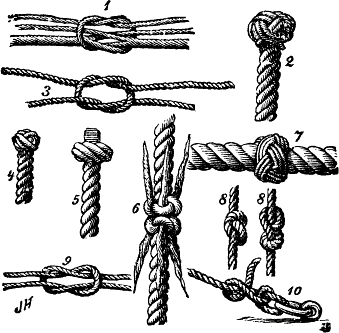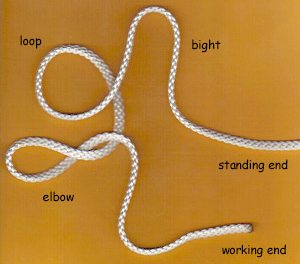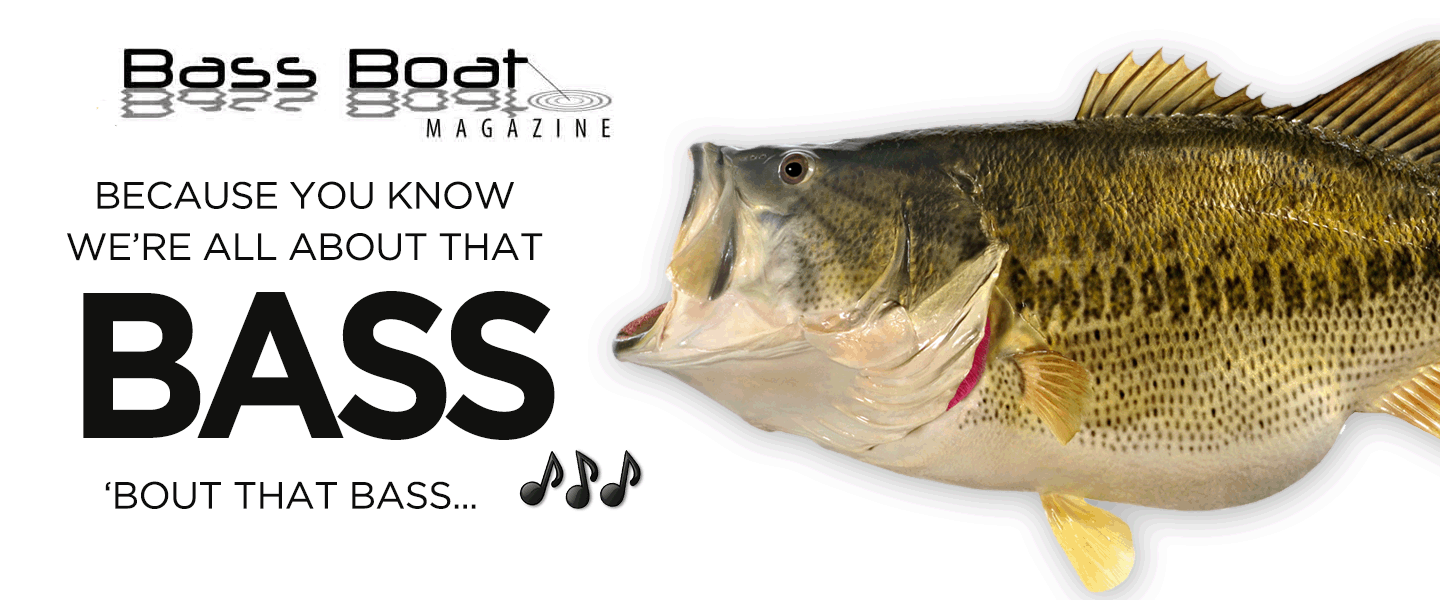A knot is a method for fastening or securing linear material such as rope by tying or interweaving. It may consist of a length of one or more segments of rope, cord, webbing, twine, string, strap or even chain interwoven so as to create in the line the ability to bind to itself or to some other object - the "load". Knots have been the subject of interest both for their ancient origins, common use, and the mathematical implications of knot theory.
Every would be sailor must know his or her ropes and become familiar with some common knots, just to be able to tie up a boat to a jetty. Then there is anchoring, then safety at sea. There are all kinds of rope and all kinds of knots, each with a different use. A 'Knot' is also a measure of speed in water, which gains its name from the distance between two knots of a piece of rope.
Usage
Some knots are well adapted to bind to particular objects such as another rope, cleat, ring, stake or to constrict an object. Decorative knots usually bind to themselves to produce attractive patterns.
Knots are essential in many industrial, work, home or recreational activities. Even simple activities such as running a load from the hardware store to home can result in disaster if a clumsy twist in a cord passes for a knot. Truckers needing to tie down a load may use a trucker's hitch, gaining mechanical advantage. Knots can save the spelunker from foolishly becoming buried under millions of tons of rock. Whatever the activity, on the water sailing or on a cliff-side rock climbing, learning well tested knots prior to some hazardous activity introduces a critical measure of safety. In addition to safety, appropriate knots can prevent the necessity of cutting lines.
In ropework, the frayed end of a rope is held together by a type of knot called a whipping knot.
Many types of textiles use knots to repair damage. Macrame, one kind of textile, is generated exclusively through the use of knotting, instead of knits, crochets, weaves or felting. Macrame can produce self-supporting three dimensional textile structures, as well as flat work, and is often used ornamentally or decoratively.

Components
<DL><DT style="MARGIN: 0px 60px; WORD-SPACING: 0px">Bight <DD>
<DD>
The center part of a length of rope, string, or yarn (cf knitting and knitting needle) as opposed to the ends. The definition changes depending on whether the definite or indefinite article is used:
<DD>More a ropeworker's term than a knot term, the reference is to the end of a rope that is tied off, hence the expression "to the bitter end". A bitt is a metal block with a crosspin used for tying lines to, found on docks.
<DT style="MARGIN: 0px 60px; WORD-SPACING: 0px"><DT style="MARGIN: 0px 60px; WORD-SPACING: 0px"><DT style="MARGIN: 0px 60px; WORD-SPACING: 0px">Efficiency <DD>
<DD>The approximate strength of a rope with a given knot as compared to the rope's strength without the knot, expressed at a percentage. A rope containing a knot is weaker than an unknotted rope, because the loops of the knot impose uneven stresses upon the rope fibers. The tighter the knot, the more uneven the stress.
<DT style="MARGIN: 0px 60px; WORD-SPACING: 0px"><DT style="MARGIN: 0px 60px; WORD-SPACING: 0px">Elbow <DD>
<DD>Two crossing points created by an extra twist in a loop.
<DT style="MARGIN: 0px 60px; WORD-SPACING: 0px"><DT style="MARGIN: 0px 60px; WORD-SPACING: 0px">Loop <DD>
<DD>A full circle formed by passing the working end over itself. Note that the term 'loop' is also used to refer to a category of knots (see 'Categories' below).
<DT style="MARGIN: 0px 60px; WORD-SPACING: 0px"><DT style="MARGIN: 0px 60px; WORD-SPACING: 0px">Standing end <DD>
<DD>The end of the rope not involved in making the knot, often shown as unfinished.
<DT style="MARGIN: 0px 60px; WORD-SPACING: 0px"><DT style="MARGIN: 0px 60px; WORD-SPACING: 0px">Standing part <DD>
<DD>Section of line between knot and the standing end.
<DT style="MARGIN: 0px 60px; WORD-SPACING: 0px"><DT style="MARGIN: 0px 60px; WORD-SPACING: 0px">Working end <DD>
<DD>The active end of a line used in making the knot. May also be called the 'running end' or 'live end'.
<DT style="MARGIN: 0px 60px; WORD-SPACING: 0px"><DT style="MARGIN: 0px 60px; WORD-SPACING: 0px">Working part <DD>
<DD>Section of line between knot and the working end.
<DT style="MARGIN: 0px 60px; WORD-SPACING: 0px"></DT></DL>

Categories
The list of knots is extensive, but common properties allow for a useful system of categorization. For example, loop knots share the attribute of having some kind of an anchor point constructed on the standing end (such as a loop or overhand knot) into which the working end is easily hitched to using a round turn. An example of this is the bowline. Constricting knots often rely on friction to cinch down tight on loose bundles; an example would be the clove hitch.
Knots may belong to more than one category:
<DL><DT style="MARGIN: 0px 60px; WORD-SPACING: 0px">Bend <DD>A knot uniting two lines (for knots joining two ends of the same line, see binding knots or loops).
<DT style="MARGIN: 0px 60px; WORD-SPACING: 0px"><DT style="MARGIN: 0px 60px; WORD-SPACING: 0px">Binding <DD>A knot that restricts object(s) by making multiple winds.
<DT style="MARGIN: 0px 60px; WORD-SPACING: 0px"><DT style="MARGIN: 0px 60px; WORD-SPACING: 0px">Coil <DD>Knots used to tie up lines for storage.
<DT style="MARGIN: 0px 60px; WORD-SPACING: 0px"><DT style="MARGIN: 0px 60px; WORD-SPACING: 0px">Decorative <DD>A complex knot exhibiting repeating patterns often constructed around and enhancing an object.
<DT style="MARGIN: 0px 60px; WORD-SPACING: 0px"><DT style="MARGIN: 0px 60px; WORD-SPACING: 0px">Hitch <DD>A knot tied to a post, cable, ring, or spar.
<DT style="MARGIN: 0px 60px; WORD-SPACING: 0px"><DT style="MARGIN: 0px 60px; WORD-SPACING: 0px">Lashing <DD>A knot used to hold (usually) poles together.
<DT style="MARGIN: 0px 60px; WORD-SPACING: 0px"><DT style="MARGIN: 0px 60px; WORD-SPACING: 0px">Loop <DD>A knot used to create a closed circle in a line.
<DT style="MARGIN: 0px 60px; WORD-SPACING: 0px"><DT style="MARGIN: 0px 60px; WORD-SPACING: 0px">Plait <DD>A number of lines interwoven in a simple regular pattern.
<DT style="MARGIN: 0px 60px; WORD-SPACING: 0px"><DT style="MARGIN: 0px 60px; WORD-SPACING: 0px">Slip (or Running) <DD>A knot tied with a hitch around one of its parts, contrasted. with a loop, which is closed with a bend. A slip knot can be closed, a loop remains the same size.
<DT style="MARGIN: 0px 60px; WORD-SPACING: 0px"><DT style="MARGIN: 0px 60px; WORD-SPACING: 0px">Seizing <DD>A knot used to hold two lines or two parts of the same line together.
<DT style="MARGIN: 0px 60px; WORD-SPACING: 0px"><DT style="MARGIN: 0px 60px; WORD-SPACING: 0px">Sennit <DD>A number of lines interwoven in a complex pattern.
<DT style="MARGIN: 0px 60px; WORD-SPACING: 0px"><DT style="MARGIN: 0px 60px; WORD-SPACING: 0px">Splice <DD>A knot formed by interweaving strands of rope rather than whole lines. More time consuming but usually stronger than simple knots.
<DT style="MARGIN: 0px 60px; WORD-SPACING: 0px"><DT style="MARGIN: 0px 60px; WORD-SPACING: 0px">Stopper <DD>A knot tied to hold a line through a hole.
<DD>A knot that is used as part of a magic trick, a joke, or a puzzle.
<DT style="MARGIN: 0px 60px; WORD-SPACING: 0px"><DT style="MARGIN: 0px 60px; WORD-SPACING: 0px">Whipping <DD>A binding knot used to prevent another line from fraying.
</DD></DL>
Every would be sailor must know his or her ropes and become familiar with some common knots, just to be able to tie up a boat to a jetty. Then there is anchoring, then safety at sea. There are all kinds of rope and all kinds of knots, each with a different use. A 'Knot' is also a measure of speed in water, which gains its name from the distance between two knots of a piece of rope.
"Basic Seamanship"
Usage
Some knots are well adapted to bind to particular objects such as another rope, cleat, ring, stake or to constrict an object. Decorative knots usually bind to themselves to produce attractive patterns.
Knots are essential in many industrial, work, home or recreational activities. Even simple activities such as running a load from the hardware store to home can result in disaster if a clumsy twist in a cord passes for a knot. Truckers needing to tie down a load may use a trucker's hitch, gaining mechanical advantage. Knots can save the spelunker from foolishly becoming buried under millions of tons of rock. Whatever the activity, on the water sailing or on a cliff-side rock climbing, learning well tested knots prior to some hazardous activity introduces a critical measure of safety. In addition to safety, appropriate knots can prevent the necessity of cutting lines.
In ropework, the frayed end of a rope is held together by a type of knot called a whipping knot.
Many types of textiles use knots to repair damage. Macrame, one kind of textile, is generated exclusively through the use of knotting, instead of knits, crochets, weaves or felting. Macrame can produce self-supporting three dimensional textile structures, as well as flat work, and is often used ornamentally or decoratively.

1. Splice 2. Manrope knot 3. Granny knot 4. Rosebud stopper knot(?) 5. Matthew Walker knot 6. Shroud knot 7. Turks head knot 8. Overhand knot, Figure-of-eight knot 9. Reef knot or Square knot 10. Two half hitches (see round turn and two half hitches)
Components
<DL><DT style="MARGIN: 0px 60px; WORD-SPACING: 0px">Bight <DD>
<DD>
The center part of a length of rope, string, or yarn (cf knitting and knitting needle) as opposed to the ends. The definition changes depending on whether the definite or indefinite article is used:
- "The bight" is any portion of the rope, string, or yarn between its two ends.
- "A bight" is a U-shaped loop used in making a knot or stitch. Many knots, such as the bowline can be tied in either the end or the bight.
<DD>More a ropeworker's term than a knot term, the reference is to the end of a rope that is tied off, hence the expression "to the bitter end". A bitt is a metal block with a crosspin used for tying lines to, found on docks.
<DT style="MARGIN: 0px 60px; WORD-SPACING: 0px"><DT style="MARGIN: 0px 60px; WORD-SPACING: 0px"><DT style="MARGIN: 0px 60px; WORD-SPACING: 0px">Efficiency <DD>
<DD>The approximate strength of a rope with a given knot as compared to the rope's strength without the knot, expressed at a percentage. A rope containing a knot is weaker than an unknotted rope, because the loops of the knot impose uneven stresses upon the rope fibers. The tighter the knot, the more uneven the stress.
<DT style="MARGIN: 0px 60px; WORD-SPACING: 0px"><DT style="MARGIN: 0px 60px; WORD-SPACING: 0px">Elbow <DD>
<DD>Two crossing points created by an extra twist in a loop.
<DT style="MARGIN: 0px 60px; WORD-SPACING: 0px"><DT style="MARGIN: 0px 60px; WORD-SPACING: 0px">Loop <DD>
<DD>A full circle formed by passing the working end over itself. Note that the term 'loop' is also used to refer to a category of knots (see 'Categories' below).
<DT style="MARGIN: 0px 60px; WORD-SPACING: 0px"><DT style="MARGIN: 0px 60px; WORD-SPACING: 0px">Standing end <DD>
<DD>The end of the rope not involved in making the knot, often shown as unfinished.
<DT style="MARGIN: 0px 60px; WORD-SPACING: 0px"><DT style="MARGIN: 0px 60px; WORD-SPACING: 0px">Standing part <DD>
<DD>Section of line between knot and the standing end.
<DT style="MARGIN: 0px 60px; WORD-SPACING: 0px"><DT style="MARGIN: 0px 60px; WORD-SPACING: 0px">Working end <DD>
<DD>The active end of a line used in making the knot. May also be called the 'running end' or 'live end'.
<DT style="MARGIN: 0px 60px; WORD-SPACING: 0px"><DT style="MARGIN: 0px 60px; WORD-SPACING: 0px">Working part <DD>
<DD>Section of line between knot and the working end.
<DT style="MARGIN: 0px 60px; WORD-SPACING: 0px"></DT></DL>

Knot components
Categories
The list of knots is extensive, but common properties allow for a useful system of categorization. For example, loop knots share the attribute of having some kind of an anchor point constructed on the standing end (such as a loop or overhand knot) into which the working end is easily hitched to using a round turn. An example of this is the bowline. Constricting knots often rely on friction to cinch down tight on loose bundles; an example would be the clove hitch.
Knots may belong to more than one category:
<DL><DT style="MARGIN: 0px 60px; WORD-SPACING: 0px">Bend <DD>A knot uniting two lines (for knots joining two ends of the same line, see binding knots or loops).
<DT style="MARGIN: 0px 60px; WORD-SPACING: 0px"><DT style="MARGIN: 0px 60px; WORD-SPACING: 0px">Binding <DD>A knot that restricts object(s) by making multiple winds.
<DT style="MARGIN: 0px 60px; WORD-SPACING: 0px"><DT style="MARGIN: 0px 60px; WORD-SPACING: 0px">Coil <DD>Knots used to tie up lines for storage.
<DT style="MARGIN: 0px 60px; WORD-SPACING: 0px"><DT style="MARGIN: 0px 60px; WORD-SPACING: 0px">Decorative <DD>A complex knot exhibiting repeating patterns often constructed around and enhancing an object.
<DT style="MARGIN: 0px 60px; WORD-SPACING: 0px"><DT style="MARGIN: 0px 60px; WORD-SPACING: 0px">Hitch <DD>A knot tied to a post, cable, ring, or spar.
<DT style="MARGIN: 0px 60px; WORD-SPACING: 0px"><DT style="MARGIN: 0px 60px; WORD-SPACING: 0px">Lashing <DD>A knot used to hold (usually) poles together.
<DT style="MARGIN: 0px 60px; WORD-SPACING: 0px"><DT style="MARGIN: 0px 60px; WORD-SPACING: 0px">Loop <DD>A knot used to create a closed circle in a line.
<DT style="MARGIN: 0px 60px; WORD-SPACING: 0px"><DT style="MARGIN: 0px 60px; WORD-SPACING: 0px">Plait <DD>A number of lines interwoven in a simple regular pattern.
<DT style="MARGIN: 0px 60px; WORD-SPACING: 0px"><DT style="MARGIN: 0px 60px; WORD-SPACING: 0px">Slip (or Running) <DD>A knot tied with a hitch around one of its parts, contrasted. with a loop, which is closed with a bend. A slip knot can be closed, a loop remains the same size.
<DT style="MARGIN: 0px 60px; WORD-SPACING: 0px"><DT style="MARGIN: 0px 60px; WORD-SPACING: 0px">Seizing <DD>A knot used to hold two lines or two parts of the same line together.
<DT style="MARGIN: 0px 60px; WORD-SPACING: 0px"><DT style="MARGIN: 0px 60px; WORD-SPACING: 0px">Sennit <DD>A number of lines interwoven in a complex pattern.
<DT style="MARGIN: 0px 60px; WORD-SPACING: 0px"><DT style="MARGIN: 0px 60px; WORD-SPACING: 0px">Splice <DD>A knot formed by interweaving strands of rope rather than whole lines. More time consuming but usually stronger than simple knots.
<DT style="MARGIN: 0px 60px; WORD-SPACING: 0px"><DT style="MARGIN: 0px 60px; WORD-SPACING: 0px">Stopper <DD>A knot tied to hold a line through a hole.
<DD>A knot that is used as part of a magic trick, a joke, or a puzzle.
<DT style="MARGIN: 0px 60px; WORD-SPACING: 0px"><DT style="MARGIN: 0px 60px; WORD-SPACING: 0px">Whipping <DD>A binding knot used to prevent another line from fraying.
</DD></DL>

